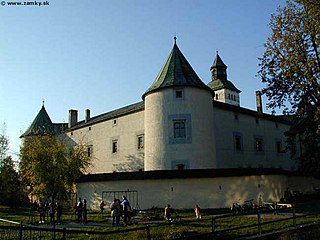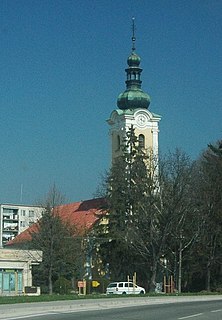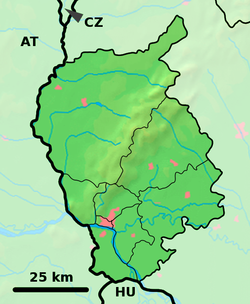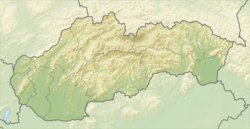
Trenčín is a city in western Slovakia of the central Váh River valley near the Czech border, around 120 km (75 mi) from Bratislava. It has a population of more than 55,000, which makes it the eighth largest municipality of the country and is the seat of the Trenčín Region and the Trenčín District. It has a medieval castle, Trenčín Castle, on a rock above the city.

Galanta is a town in the Trnava Region of Slovakia. It is situated 50 km due east of the Slovak capital Bratislava.

Bytča is a town in northwestern Slovakia. It is located on the Váh River near the cities of Žilina and Považská Bystrica. It belongs to Upper Váh region of tourism.

Pezinok is a town in southwestern Slovakia. It is roughly 20 km (12.43 mi) northeast of Bratislava and, as of December 2018, had a population of 23,002.

Ilava is a town in the Trenčín Region, northwestern Slovakia.

Hlohovec (German: Freistad an der Waag, Hungarian Galgóc, is a town in southwestern Slovakia, with a population of 21,508.

Michalovce is a town on the Laborec river in eastern Slovakia. Originally named after the Archangel St Michael, it is the second-largest city in the Košice Region and the seat of the Michalovce District.

Kremnica is a town in central Slovakia. It has around 5,300 inhabitants. The well-preserved medieval town built above important gold mines is the site of the oldest still-working mint in the world.

Dubnica nad Váhom is a town in the Ilava District, Trenčín Region in Slovakia.

Modra is a city and municipality in the Bratislava Region in Slovakia. It has a population of 9,042 as of 2018. It nestles in the foothills of the Malé Karpaty and is an excellent centre of hiking.

Nové Mesto nad Váhom is a town in the Trenčín Region of Slovakia.

Gelnica is a town in the Košice Region of Eastern Slovakia. It has a population of 6,076.

Svätý Jur is a small historical town northeast of Bratislava, located in the Bratislava Region. The city is situated on the slopes of Little Carpathians mountains and surrounded by typical terraced vineyards with more than 700 years of winemaking tradition. In 1990, the intact city center was declared a protected city reservation. Cadastrially, Svätý Jur includes also the natural reserve Šúr, established in 1952 to protect one of the last and largest remnants of a tall-stem swamp alder forest in Central Europe.

Sereď is a town in southern Slovak Republic near Trnava, on the right bank of the Váh River on the Danubian Lowland. It has approximately 15,500 inhabitants.

Senica is a town in Trnava Region, western Slovakia. It is located in the north-eastern part of the Záhorie lowland, close to the Little Carpathians.

Myjava is a town in Trenčín Region, Slovakia.

Veľký Šariš is a small town near Prešov in eastern Slovakia. The town is known as the site of the largest brewery in Slovakia – Šariš Brewery.

Modrý Kameň is a town and municipality in the Veľký Krtíš District of the Banská Bystrica Region of southern Slovakia.

Holíč is a town in western Slovakia.

Stará Turá is a town in the Trenčín Region in western Slovakia.






















